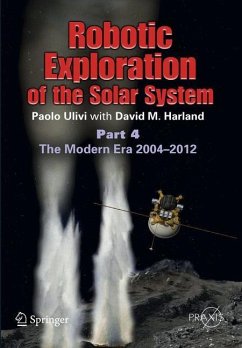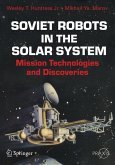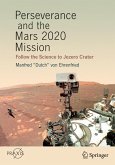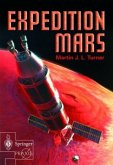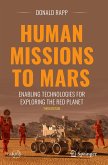This series of four books marks the 50th anniversary of the start of the "space age," which opened with the launch of Sputnik in 1957, by providing a comprehensive account of how we have used robotic spacecraft to explore the Solar System. It starts with a review of what we knew - or thought we knew - about the Solar System immediately prior to dispatching the first space probes, and then discusses each project and the results obtained, to progressively explain how our knowledge of the Solar System has increased over the years.
"Part 4: The Modern Era 2004 - 2012" focuses on the robotic missions initiated since 2004, including NASA's Mars Reconnaissance Orbiter, the Phoenix Mars lander, the Curiosity rover, the foiled Russian mission to the Martian moon Phobos, the joint NASA-European orbiters and rovers for Mars, and attempts by China, Japan and India to send probes. "Part 4" also discusses missions to other destinations, including the Rosetta, Deep Impact and EPOXI comet missions, the MESSENGER orbiter for Mercury, the European Venus Express orbiter, the troubled Japanese mission to Venus, the Dawn mission to the asteroids Vesta and Ceres, and the New Horizons mission to Pluto. The book concludes with a look ahead to possible future robotic missions and the prospect of sending humans to the Red Planet. It includes comprehensive appendices of data on the missions flown in the period 2004 to 2012, bringing the series up to date.
In Robotic Exploration of the Solar System, Paolo Ulivi and David Harland provide a comprehensive account of the design and management of deep-space missions, the spacecraft involved - some flown, others not - their instruments, and their scientific results.
This fourth volume in the series covers the period 2004 to the present day and features:
coverage of the Rosetta and Curiosity missions up to the end of 2013coverage of Mars missions since 2005, including the Mars Reconnaissance Orbiter, Phoenix and Fobos-Grunt, plus a description of plans for future robotic exploration of the Red Planetcoverage of all planetary missions launched between 2004 and 2013, including the Deep Impact cometary mission, the MESSENGER Mercury orbiter, the New Horizons Pluto flyby and the Juno Jupiter orbiterthe first complete description of the Chinese Chang'e 2 asteroid flyby mission ever publishedextensive coverage of future missions, including the European BepiColombo Mercury orbiter and international plans to revisit the most interesting moons of Jupiter and Saturn.
"Part 4: The Modern Era 2004 - 2012" focuses on the robotic missions initiated since 2004, including NASA's Mars Reconnaissance Orbiter, the Phoenix Mars lander, the Curiosity rover, the foiled Russian mission to the Martian moon Phobos, the joint NASA-European orbiters and rovers for Mars, and attempts by China, Japan and India to send probes. "Part 4" also discusses missions to other destinations, including the Rosetta, Deep Impact and EPOXI comet missions, the MESSENGER orbiter for Mercury, the European Venus Express orbiter, the troubled Japanese mission to Venus, the Dawn mission to the asteroids Vesta and Ceres, and the New Horizons mission to Pluto. The book concludes with a look ahead to possible future robotic missions and the prospect of sending humans to the Red Planet. It includes comprehensive appendices of data on the missions flown in the period 2004 to 2012, bringing the series up to date.
In Robotic Exploration of the Solar System, Paolo Ulivi and David Harland provide a comprehensive account of the design and management of deep-space missions, the spacecraft involved - some flown, others not - their instruments, and their scientific results.
This fourth volume in the series covers the period 2004 to the present day and features:
coverage of the Rosetta and Curiosity missions up to the end of 2013coverage of Mars missions since 2005, including the Mars Reconnaissance Orbiter, Phoenix and Fobos-Grunt, plus a description of plans for future robotic exploration of the Red Planetcoverage of all planetary missions launched between 2004 and 2013, including the Deep Impact cometary mission, the MESSENGER Mercury orbiter, the New Horizons Pluto flyby and the Juno Jupiter orbiterthe first complete description of the Chinese Chang'e 2 asteroid flyby mission ever publishedextensive coverage of future missions, including the European BepiColombo Mercury orbiter and international plans to revisit the most interesting moons of Jupiter and Saturn.
"This work completes the authors' review of Solar System missions up to about 2013. ... I particularly liked the selection of photographs, both technological and scientific, many of which I had never seen before. ... as source of detailed descriptions of any planetary mission you have heard of, and possibly a few you haven't, it is an excellent reference source." (John Davies, The Observatory, April, 2016)
"Space historians Ulivi and Harland serve up the fourth book in this series on international planetary exploration missions, covering the most recent ten years. Their compendium does a superb job of capturing what seems like 'insider' details of each major mission. ... This fourth volume could stand on its own as a reference for those interested only in modern missions. ... Summing Up: Highly recommended. All space history/exploration collections." (T. D. Oswalt, Choice, Vol. 52 (9), May, 2015)
"Space historians Ulivi and Harland serve up the fourth book in this series on international planetary exploration missions, covering the most recent ten years. Their compendium does a superb job of capturing what seems like 'insider' details of each major mission. ... This fourth volume could stand on its own as a reference for those interested only in modern missions. ... Summing Up: Highly recommended. All space history/exploration collections." (T. D. Oswalt, Choice, Vol. 52 (9), May, 2015)

